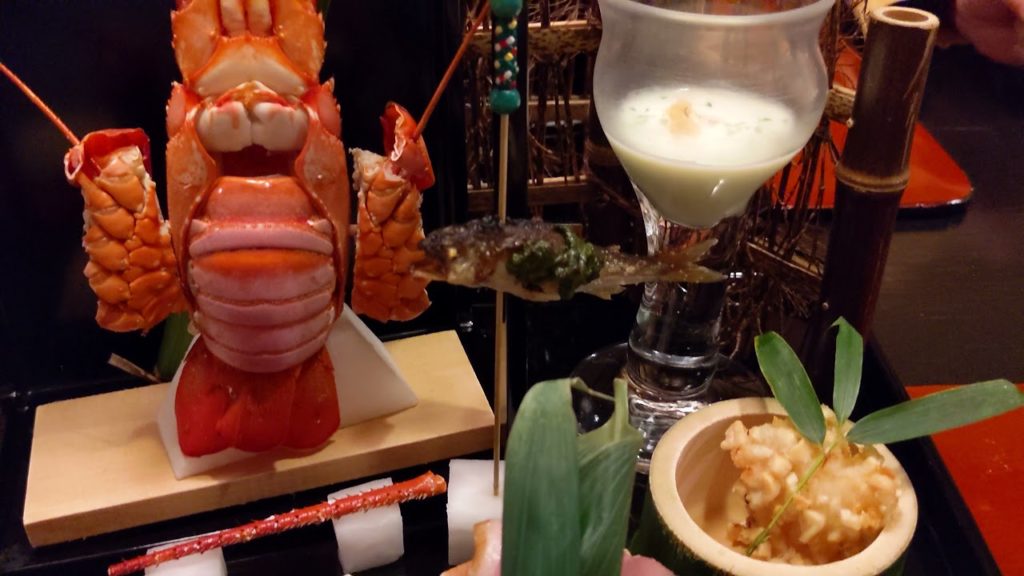We were served Kaiseki dinner in our room (room name: Oimatsu – 老松) at Teien No Yado Sekitei (庭園の宿 石亭), a boutique ryokan in Hatsukaichi, Hiroshima, Japan (広島県廿日市市.) The seasonal offerings were brand new as of the day we arrived, so there was some confusion as to what each serving was. Still, we really enjoyed everything. The explanation of each offering was in Japanese, but I’ve done my best to explain everything below:
COURSE 1 – Sakizuke (先付 – Appetizers) – Anago Zanmai (穴子三昧 – Conger Eel Medley):
* Anago to Uni no Gomajoyu-ae (穴子と雲丹の胡麻醬油和え – Conger Eel and Sea Urchin flavored with Sesame Soy Sauce)
– Shiraga Negi (白髪葱 – Green Onions thinly cut like graying hair)
– Hari Nori (針海苔 – Thinly-cut Nori)
– Oba (大葉 – Perilla)
– Wasabi (山葵)
– Hanaho (花穂 – Edible Perilla flower)
* Anago Futami-yaki (穴子二味焼き – Conger Eel presented in a Futami)
– Shirayaki to Saikyo Misoyaki (白焼きと西京味噌焼 – Conger Eel grilled with salt / Conger Eel marinated in white miso paste)
– Anago Kuromai-age (穴子黒米揚げ)
COURSE 2 – Wan (椀 – Soup):
* Yamabuki Ainame to Warabi Shinjo (山吹油目と蕨真薯 – Clear Soup with Fish Cake consisting of Fat Greenling from Yamabuki and Eagle Fern)
COURSE 3 – Tsukuri (造里 – Sashimi):
* Akagai (赤貝 – Ark Shell)
* Tachiuo (太刀魚 – Cutlass Fish)
* Okoze (オコゼ – Stonefish)
* Maguro & Toro (マグロ & トロ – Tuna & Fatty Tuna)
* Shima Aji (縞鯵 – Striped Jack)
* Sawara (鰆 – Japanese Spanish Mackerel)
* Kensaki Ika (剣鳥賊 – Swordtip Squid)
COURSE 4 – Hassun (八寸 – Seasonal Platter):
* Ise Ebi Kabuto Mitate (伊勢海老甲冑見立 – Ise/Spiny Lobster prepared to look like a Samurai Helmet – just for decoration; not edible)
* Ni Anago Chimaki Mitate (煮穴子粽見立 – Simmered Conger Eel wrapped in a leaf)
* Chiayu Kinome-yaki (稚鮎木の芽焼き)
* Shin Renkon (新蓮根 – “New” Lotus Root)
* Haru Kyabetsu (春キャベツ – Spring Cabbage)
* Kabocha (南瓜)
* Shinjaga to Jinseki Pork No Canape (新じゃがと神石ポークのカナッペ – New Potato and Pork from Jinseki Canape)
* Tainoko Karasumi (鯛ノ子唐墨仕立て – Sea Bream Roe prepared like Bottarga Karasumi)
* Soramame Reisei (蚕豆冷製スープ – Soramame Cold Soup)
* Haru Kamo Hazakura-mushi (春鴨葉桜蒸し – Steamed Spring Duck Mushed with Sakura leaves)
* Makomo-dake Olanda (マコモ筍オランダ – Water Bamboo)
* Fuki to Asari No Hitashi (蕗と浅利の浸し – Japanese Butterbur plant and Clams in Soy-based broth)
COURSE 5:
* FOR HER: Toro Nigiri Sushi (トロにぎり寿司 – Fatty Tuna Nigiri Sushi)
* FOR HIM: Hiroshima Jinseki Wagyu Filet (神石和牛フィレ肉 – Jinseki Beef Filet from Hiroshima)
COURSE 6 – Hashi Yasume (箸休 – “Rest the Chopstick”):
* Hamaguri to Aosa Nori No Meshimushi (蛤と青さ海苔の飯蒸し – Steamed Common Hard Clam and Aosa Seawood over Rice with broth)
COURSE 7 – Yaki Zakana (焼肴):
* Masu Saikyo-yaki (鱒西京焼 – Miso-marinated and grilled Trout)
* Hatsugatsuo Sumibi Aburi (初鰹炭火炙り – Lightly charcoal-seared Spring Bonito)
* Tai No Shirako Tofu (鯛の白子豆腐 – Red Sea Bream Milt Tofu)
* Myoga (茗荷 – Japanese Ginger)
* Amanaga Togarashi (甘長唐辛子 – Non-hot Green Pepper)
* Takenoko (筍 – Bamboo Shoots)
COURSE 8 – Shimezakana (〆肴):
* Yomogi Soba (蓬蕎麦 – Soba noodles containing Japanese Mugwort accompanied with fried Japanese Mugwort)
COURSE 9 – Shokuji (食事 – Rice Dish):
* Anago Kamadaki Gohan (穴子釜炊きご飯 – Conger Eel and Rice cooked in a special Japanese pot)
* Tomewan (止椀 – Miso Soup)
* Kounomono (香の物 – Pickled vegetables)
COURSE 10 – Kanmi (甘味 – Dessert):
* Sakuranbo Mousse to Jelly (サクランボのムースとゼリ- – Cherry Mousse with Cherry Jelly on top)


AloJapan.com